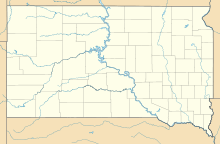| Wounded Knee Massacre | |||||||
|---|---|---|---|---|---|---|---|
| Part of the Ghost Dance War and the Sioux Wars | |||||||
 Mass grave for the Lakota dead after the massacre | |||||||
| |||||||
| Belligerents | |||||||
|
|
Miniconjou Lakota Hunkpapa Lakota | ||||||
| Commanders and leaders | |||||||
|
| Spotted Elk † | ||||||
| Strength | |||||||
| 490[1] | 120[2] | ||||||
| Casualties and losses | |||||||
|
31 killed 33 wounded |
90 killed 4 wounded | ||||||
|
200 civilians killed 46 civilians wounded[3][4] | |||||||
Location within South Dakota | |||||||
The Wounded Knee Massacre, also known as the Battle of Wounded Knee, was the massacre of nearly three hundred Lakota people by soldiers of the United States Army. The massacre, part of what the U.S. military called the Pine Ridge Campaign,[5] occurred on December 29, 1890,[6] near Wounded Knee Creek (Lakota: Čhaŋkpé Ópi Wakpála) on the Lakota Pine Ridge Indian Reservation in South Dakota, following a botched attempt to disarm the Lakota camp. The previous day, a detachment of the U.S. 7th Cavalry Regiment commanded by Major Samuel M. Whitside approached Spotted Elk's band of Miniconjou Lakota and 38 Hunkpapa Lakota near Porcupine Butte and escorted them five miles (eight kilometers) westward to Wounded Knee Creek, where they made camp. The remainder of the 7th Cavalry Regiment, led by Colonel James W. Forsyth, arrived and surrounded the encampment. The regiment was supported by a battery of four Hotchkiss mountain guns.[7] The Army was catering to the anxiety of settlers who called the conflict the Messiah War and were worried the Ghost Dance signified a potentially dangerous Sioux resurgence. Historian Jeffrey Ostler wrote in 2004, "Wounded Knee was not made up of a series of discrete unconnected events. Instead, from the disarming to the burial of the dead, it consisted of a series of acts held together by an underlying logic of racist domination."[8]
On the morning of December 29, the U.S. Cavalry troops went into the camp to disarm the Lakota. One version of events maintains that during the process of disarming the Lakota, a deaf tribesman named Black Coyote was reluctant to give up his rifle, claiming he had paid a lot for it.[9] Black Coyote's rifle went off at that point; the U.S. Army began shooting at the Lakota. The Lakota warriors fought back, but many had already been stripped of their guns and disarmed.[10]
By the time the massacre was over, more than 250 people of the Lakota had been killed and 51 were wounded (4 men and 47 women and children, some of whom died later); some estimates placed the number of dead as high as 300.[3] Twenty-five soldiers also were killed and thirty-nine were wounded (six of the wounded later died).[11] Nineteen soldiers were awarded the Medal of Honor specifically for Wounded Knee, and overall 31 for the campaign.[12][13] In 2001, the National Congress of American Indians passed two resolutions condemning the military awards and called on the federal government to rescind them.[14] The Wounded Knee National Historic Landmark, the site of the massacre, has been designated a National Historic Landmark by the U.S. Department of the Interior.[6] In 1990, both houses of the U.S. Congress passed a resolution on the historical centennial formally expressing "deep regret" for the massacre.[15]
- ^ Utley (2004), p. 201.
- ^ Brown (2009), p. 178, Brown states that at the army camp, "the Indians were carefully counted." Utley (2004), p. 204, gives 120 men, 230 women and children; there is no indication how many were warriors, old men, or incapacitated sick like Foot.
- ^ a b "Plains Humanities: Wounded Knee Massacre". Archived from the original on December 10, 2014. Retrieved December 9, 2014.
resulted in the deaths of more than 250, and possibly as many as 300, Indians.
- ^ Nelson A. Miles to the Commissioner of Indian Affairs, March 13, 1917, "The official reports make the number killed 90 warriors and approximately 200 women and children."
- ^ Greene, Jerome A. (January 31, 2007). Indian War Veterans: Memories of Army Life and Campaigns in the West, 1864–1898. Savas Beatie. p. 193. ISBN 978-1-61121-022-4.
- ^ a b "National Historic Landmarks Program: Wounded Knee". National Park Service. Archived from the original on January 10, 2003. Retrieved January 10, 2008.
- ^ Liggett, Lorie (1998). "Wounded Knee Massacre – An Introduction". Bowling Green State University. Archived from the original on October 30, 2000. Retrieved March 2, 2007.
- ^ PRUCHA, FRANCIS PAUL (2005). Ostler, Jeffrey (ed.). "Wounded Knee through the Lens of Colonialism". Diplomatic History. 29 (4): 725–728. doi:10.1111/j.1467-7709.2005.00512.x. ISSN 0145-2096. JSTOR 24915067.
- ^ Parsons, Randy. "The Wounded Knee Massacre – December 1890". Lastoftheindependents.com. Archived from the original on January 6, 2010. Retrieved August 17, 2011.
- ^ "PBS – The West – Like Grass Before the Sickle". www.pbs.org.
- ^ Jack Utter (1991). Wounded Knee & the Ghost Dance Tragedy (1st ed.). National Woodlands Publishing Company. p. 25. ISBN 0-9628075-1-6.
- ^ Greene, Jerome A. (2014). American Carnage: Wounded Knee, 1890. Norman, OK: University of Oklahoma Press. pp. 417–418. ISBN 978-0-8061-4448-1.
- ^ "An alternative proposal for the Wounded Knee medal problem". January 3, 2024.
- ^ Cite error: The named reference
Congresswas invoked but never defined (see the help page). - ^ AP (October 29, 1990). "Congress Adjourns – Century Afterward, Apology For Wounded Knee Massacre". The New York Times. Pine Ridge Indian Reservation (Sd); United States. Retrieved July 26, 2016.

